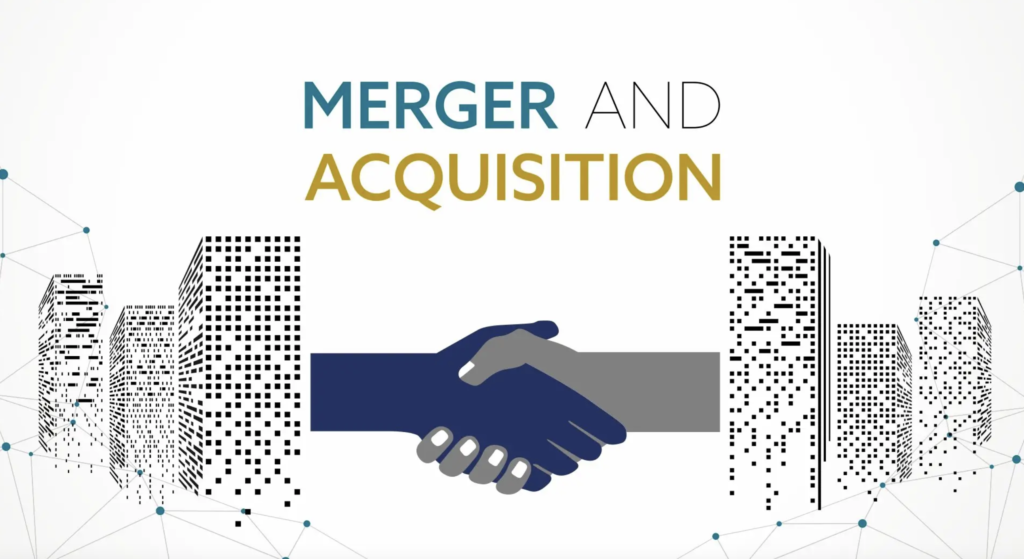Understanding the Fundamentals of Mergers and Acquisitions
Consolidating two or more businesses into one single organisation is referred to as a merger or acquisition (M&A). This can take the kind of a merger, in which two businesses come together to establish a new business, or an acquisition, in which one business purchases another business.
In this post, we’ll look at the fundamentals of mergers and acquisitions and give a rundown of the main factors to take into account.
What Causes Mergers and Acquisitions?
Various factors, such as the following, can lead to mergers and acquisitions:
- Market Consolidation: M&A can be used to improve a company’s dominance in a specific market or industry by consolidating market share.
- Synergies: It may be possible to gain cost savings and boost operational efficiencies by integrating two businesses. This may be especially true for businesses with complementary skills and competencies.
- Access to New Markets: Through mergers and acquisitions, businesses can gain access to fresh markets, clients, and revenue sources. This might be crucial for businesses attempting to grow into new markets or geographic areas.
- Diversification: Companies’ exposure to any one market or product line can be decreased by diversification, which M&A can offer.
- Access to Talent: M&A can give businesses access to fresh talent and knowledge, enabling them to stay competitive in a market that is changing quickly.
Mergers and Acquisitions: Types
Mergers and acquisitions come in a variety of forms, including:
- Horizontal Merger: In a horizontal merger, two businesses that are directly competing with one another are combined. Companies may benefit from this by reducing competition and increasing market share.
- Vertical Merger: In a vertical merger, two businesses that are involved in various phases of the production process are combined. This can assist businesses in cost-cutting and supply chain improvement.
- Conglomerate Merger: In a conglomerate merger, two businesses that are not in the same sector or market are combined. Due to less vulnerability to any one market or product line, businesses can diversify their operations and increase their resilience.
- Reverse Merger: In a reverse merger, a private corporation buys out a publicly traded firm. As a result, the private company may have easier access to capital markets and a quicker procedure for going public.
The Process of Mergers and Acquisitions
The M&A procedure typically consists of several crucial components, including:
Due diligence is the procedure of assessing the target business to ascertain its operational, financial, and strategic viability. Examining financial statements, contracts, and other important documents may fall under this category.
The two businesses will negotiate the specifics of the deal, including the purchase price, financing arrangements, and other important aspects, once the due diligence process is over:
- Integration: If the transaction goes through, the two businesses will have to combine their cultures, systems, and operations. It may be a difficult process that needs careful preparation and execution.
- Post-Merger Evaluation: It’s crucial to assess the effects of the merger or acquisition on the company’s operations and pinpoint any areas that require improvement.
Mergers and acquisitions factors
When engaging in mergers and acquisitions, businesses should bear the following important factors in mind:
- Strategic Match: It’s crucial to confirm that the target business and the acquiring business have a solid strategic fit. This can make it more likely that the two businesses will complement one another and create synergies.
- Financial viability: Businesses should think about how the merger or acquisition will affect their bottom line, taking into account the purchase price, financing options, and anticipated return on investment.
- Cultural Fit: Because system, process, and cultural changes are frequently necessary, mergers and acquisitions can be difficult for staff members. When considering an M&A, businesses should keep this in mind and make sure to think about how the cultures of the two organisations will mesh.
- Regulatory Permission: Some mergers and acquisitions could need regulatory approval, which can make the process more difficult and time-consuming. Businesses should be aware of any applicable laws and rules and follow all legal requirements.
- Integration Risks: Merging two businesses may be a difficult process, and there are a number of risks involved, such as the possibility that synergies won’t be achieved, that key people will leave, and the expense of the integration itself.
In order to reduce the impact of these risks, businesses should thoroughly evaluate them and create an elaborate integration strategy.
How Are Acquisitions Funded?
A corporation can buy another company using cash, shares, debt assumption, or a mix of the three. In smaller transactions, it is also usual for one firm to purchase all of the assets of another company.
Company X purchases all of Company Y’s assets for cash, leaving Company Y with only cash (and debt, if any). Of course, Company Y becomes a shell and will eventually liquidate or enter new markets.
A reverse merger is another type of purchase arrangement that allows a private firm to become publicly traded in a relatively short amount of time.
Reverse mergers occur when a private corporation with promising prospects and a strong desire for financing acquires a publicly traded shell company with no actual business operations and little assets.
The private firm reverses its merger with the public company, and the two companies merge to form an entirely new public corporation with marketable shares.
How are mergers and acquisitions valued?
The target company will be valued differently by both companies involved in an M&A transaction. The seller will undoubtedly value the company at the highest possible price, whereas the buyer will want to purchase it at the lowest feasible price.
Fortunately, a company can be objectively valued by researching comparable companies in a sector and depending on the measures listed below.
P/E Ratio (Price-to-Earnings Ratio)
An acquiring business uses a price-to-earnings ratio (P/E ratio) to make an offer that is a multiple of the target company’s earnings. Examining the P/E multiples for all stocks in the same industry group will provide the acquiring business with a good indication of what the target’s P/E multiple should be.
Enterprise-Value-to-Sales (EV/Sales) Ratio
The purchasing corporation uses an enterprise-value-to-sales ratio (EV/sales) to make an offer as a multiple of revenues while keeping in mind the price-to-sales (P/S ratio) of competing companies in the industry.
Discounted Cash Flow (DCF) (DCF)
A discounted cash flow (DFC) analysis, a key valuation tool in M&A, calculates a company’s current value based on its expected future cash flows.
Forecasted free cash flows are discounted to present value using the company’s weighted average cost of capital (net income + depreciation/amortization (capital expenditures) change in working capital) (WACC).
To be sure, DCF is difficult to master, but few tools can compete with it.
Cost of Replacement
Acquisitions are sometimes based on the cost of replacing the target company. Assume that the worth of a corporation is simply the sum of its equipment and personnel costs. The purchasing corporation can almost command the target to sell at that price, or it will build a competitor at the same price.
Naturally, assembling strong management, acquiring property, and purchasing the necessary equipment takes time. This method of determining a price makes little sense in a service industry when the essential assets (people and ideas) are difficult to evaluate and develop.
What Is the Difference Between Mergers and Acquisitions?
In general, a “acquisition” refers to a transaction in which one company absorbs another through a takeover. When the acquiring and target corporations join to establish a wholly new entity, the word “merger” is employed.
Because each combination is a distinct situation with its own features and motivations for engaging in the transaction, the use of these phrases frequently overlaps.
Why do companies continue to acquire other businesses through mergers and acquisitions?
Competition and expansion are two key drivers of capitalism. When faced with competition, a corporation must minimise costs while also innovating. One strategy is to buy out competitors so that they no longer pose a danger.
M&A is also used by businesses to expand by acquiring additional product lines, intellectual property, human resources, and client bases. Businesses may also seek synergy.
By integrating corporate activities, total performance efficiency improves and overall costs decrease as one company capitalises on the strengths of the other.
What Exactly Is a Hostile Takeover?
The most common type of acquisition is a friendly acquisition, which occurs when the target company agrees to be purchased; its board of directors and shareholders approve of the transaction; and these combinations frequently operate for the mutual advantage of the acquiring and target companies.
When the target company refuses to consent to the acquisition, it is referred to as an unfriendly acquisition.
Because the target firm does not have the same agreement in hostile acquisitions, the acquiring firm must aggressively purchase big holdings in the target company to gain a controlling position, which compels the acquisition.
What Impact Does M&A Have on Shareholders?
In general, shareholders of the acquiring firm will witness a short reduction in share value in the days leading up to a merger or acquisition. At the same time, the value of the target firm’s shares often rises.
This is frequently owing to the acquiring firm’s requirement for funds to acquire the target firm at a premium to pre-takeover share prices.
The stock price frequently exceeds the worth of each underlying company during its pre-takeover stage once a merger or acquisition officially takes effect. In the absence of unfavourable economic conditions, the merged company’s owners often enjoy good long-term performance and dividends.
It should be noted that the increased number of shares released during the merger procedure may result in a dilution of voting power for both firms’ owners. This occurrence is prevalent in stock-for-stock mergers, in which the new business exchanges its shares for shares in the target company at an agreed-upon conversion rate.
Owners in the acquiring firm lose a minimal amount of voting power, whereas shareholders in a smaller target company may lose a significant amount of voting power in the comparably larger pool of stakeholders.
Conclusion
In conclusion, mergers and acquisitions can be a useful strategy for businesses aiming to increase operational efficiency, expand into new markets, hire top personnel, or diversify their business lines.
However, they can also be complicated and difficult, so before moving forward, businesses should carefully assess the strategic, monetary, and cultural ramifications of M&A.
Companies may successfully traverse the M&A landscape and accomplish their strategic goals by working with knowledgeable consultants and taking the time to understand the procedure.




